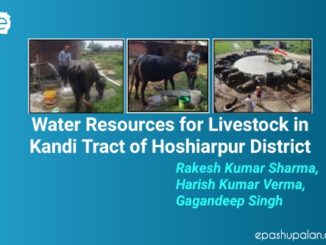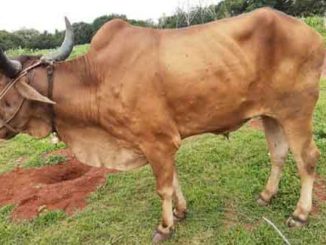Nature of the disease
Haemorrhagic septicaemia (HS) is a contagious bacterial disease caused by two serotypes of Pasteurella multocida, B2 and E2. It affects cattle (Bos taurus and B. indicus) and water buffaloes (Bubalus bubalis) with a high mortality rate in infected animals. It is regarded as one of the most serious diseases of large ruminants in south east Asia.
Transmission, Epidemiology, and Pathogenesis
The tonsils of up to 5% of healthy water buffalo and cattle are colonized by small numbers of P multocida serotype B:2 or E:2, which can be shed during periods of stress. Common stressors associated with outbreaks include high temperature and humidity, concurrent infection (blood parasites or foot and mouth disease), poor nutrition, or work stress. Although outbreaks can occur at any time, disease is most prevalent during the rainy season. Increased outbreaks associated with high rainfall are most likely due to the multiple stressors present during this time and the moist conditions, which prolong the survival time of the organism in the environment. Infection occurs by contact with infected oral or nasal secretions from either healthy carrier animals or animals with clinical disease, or by ingestion of contaminated feed or water. Infection begins in the tonsil and adjacent nasopharyngeal tissues. Subsequently, bacteremia leads to dissemination and rapid growth of bacteria in various locations, tissue injury, a host cytokine response, and release of lipopolysaccharides that results in a rapidly progressing endotoxemia. Clinical signs can appear 1–3 days after infection, and death can occur within 8–24 hr after the first signs develop. In endemic areas, HS affects older calves and young adults, and morbidity and mortality are variable. In nonendemic areas, epizootics can occur with high morbidity and mortality that can reach 100%. Water buffalo tend to be more susceptible and have more severe clinical disease than cattle. Recovery can stimulate acquired immunity to homologous and often heterologous strains of P multocida, and some of these animals become healthy carriers that can provide a source of infection for future outbreaks.

Susceptible species
The water buffalo is the most susceptible species, followed by cattle.
Distribution
HS occurs in South and South East Asia, the Middle East and most of Africa, the disease has also been reported to occur occasionally in Southern Europe.
Clinical signs
Most cases are acute or per-acute. The following signs are seen:
- High fever
- Depression
- Reluctance to move
- Salivation and nasal discharge
- Painful, oedematous swelling of the throat, extending to the brisket
- Congested mucous membranes
- Respiratory distress
- Calves may have a haemorrhagic gastro-enteritis
- Death in 6-48 hours after onset of clinical signs. Recovery is rare.
Lesions
The characteristic lesion of HS is swelling of the subcutis and muscle of the submandibular region, neck, and brisket by clear to blood-tinged edema fluid. Serous to serofibrinous fluid may also be present in the thorax, pericardium, and abdominal cavity. There is typically widespread congestion with petechiae and ecchymoses in tissues and on serosal surfaces. Hemorrhages are often most prominent in the pharyngeal and cervical lymph nodes. Pulmonary congestion and edema, sometimes with interstitial pneumonia, and gastroenteritis may occur in some cases.
Post-mortem findings
- Oedematous swellings of the throat-brisket contain a clear, straw-coloured serous fluid
- Blood-tinged fluid in body cavities
- Pharyngeal and cervical lymph nodes are swollen and congested
- Subserosal petechial haemorrhages
- Generalised congestion of the lungs
- Variable congestion of the abomasum and intestinal tract
- Calves may have haemorrhagic gastro-enteritis
Gross lesions will be minimal in animals that have died quickly.
Differential diagnosis
- Blackleg
- Rinderpest.
Specimens required for diagnosis
The diagnosis is based on the isolation of Pasteurella multocida.
Heparinized blood from live animals or affected tissue from fresh post-mortem should be collected aseptically. Samples should be kept cool and shipped on wet ice as soon as possible. Swabs in transport media, ribs, and tips of ears are sometimes submitted from remote areas in developing countries.
Transmission
HS is principally a disease of animals under stress. In endemic areas about 2% of healthy cattle and buffalo carry the organism in lymphatic tissue of the upper respiratory tract. Intermittently, even in the presence of circulating antibody, the organisms invade the nasopharynx and are excreted in nasal secretions. These episodes may be triggered by stress.
Infection is transmitted by:
- Direct contact between animals
- Contaminated feedstuffs or water
The bacterium does not survive in the environment for more than a few days.
Risk of introduction
Because the organism survives poorly outside the host, it is unlikely that it would be introduced to a new area except by the introduction of live animals. N.B. healthy animals can carry the organism.
Restriction of imports of live animals from endemically infected countries, would keep the risk of introduction low.
Treatment and Prevention
Antimicrobials are effective against HS if administered very early in the disease. However, because HS progresses rapidly, therapy is often unsuccessful. During outbreaks, any animal with a fever should be treated with IV antimicrobials as soon as possible to quickly obtain systemic bactericidal antimicrobial concentrations. Various sulfonamides, tetracyclines, penicillin, gentamicin, kanamycin, ceftiofur, enrofloxacin, tilmicosin, and chloramphenicol have been used effectively to treat HS. However, plasmid- and chromosomal-mediated multidrug resistance seems to be increasing for some strains of P multocida, and resistance to tetracyclines and penicillin has been reported for serotype B:2.
Killed vaccines are most commonly used for prevention and include bacterins, alum-precipitated and aluminum hydroxide gel vaccines, and oil-adjuvant vaccines. In animals >3 yr old, an initial two doses, 1–3 mo apart, is recommended, followed by booster vaccinations once or twice yearly. The oil-adjuvant vaccine provides protection for 9–12 mo and is given annually. Although it provides the best immunity, it is unpopular in the field because of its viscosity and difficulty of administration. Oil-based vaccines combined with tween 80 or saponin have also been used in attempts to increase the ease of administration or immune protection. The commonly used alum-precipitated and aluminum hydroxide gel vaccines have shorter durations of immunity, and twice yearly booster vaccinations are recommended. It is important that the vaccines are made from the strains of P multocida circulating in the regions of intended use to obtain maximal effectiveness. Attenuated or modified-live vaccines have been used with some success. A live avirulent vaccine prepared from a P multocida serotype B:3(4) of fallow deer origin seems effective and is recommended for use by the Food and Agricultural Organization of the United Nations (FAO) in southeast Asia. Various modified-live and subunit vaccines made from either purified or recombinant bacterial components have also been investigated experimentally.
Control/ vaccines
In endemically infected areas, annual immunization using adjuvant vaccines gives good control. Whether HS can be eradicated from an area by comprehensive vaccination campaigns is unclear.
|
The content of the articles are accurate and true to the best of the author’s knowledge. It is not meant to substitute for diagnosis, prognosis, treatment, prescription, or formal and individualized advice from a veterinary medical professional. Animals exhibiting signs and symptoms of distress should be seen by a veterinarian immediately. |






Be the first to comment